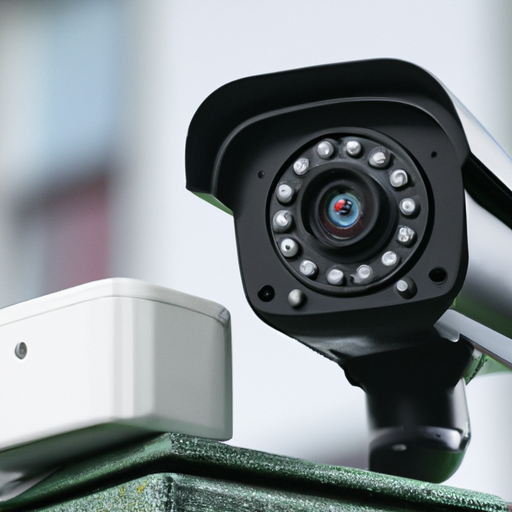
In this article, we will discuss the role that a Network Video Recorder (NVR) and a Digital Video Recorder (DVR) play in a security system. We will explore how these devices are used to record and store video footage from surveillance cameras, as well as the differences between the two. By the end of this article, you will have a clear understanding of the important functions that NVRs and DVRs serve in ensuring the safety and security of your property.
This image is property of images.unsplash.com.
Overview of NVR and DVR
Definition of NVR
A Network Video Recorder (NVR) is a device that is used to record and store video footage from IP cameras. It operates on an IP-based network and is specifically designed to work seamlessly with IP cameras. The NVR acts as a central hub for surveillance cameras, allowing users to view, manage, and store video feeds from multiple cameras at once.
Definition of DVR
On the other hand, a Digital Video Recorder (DVR) is a device that is used to record and store video footage from analog cameras. Unlike the NVR, which works with IP cameras, the DVR is compatible with analog cameras. It converts analog video signals into digital format and then compresses and stores the footage on a built-in hard drive.
Differences between NVR and DVR
The main difference between NVR and DVR lies in their compatibility with different types of cameras. NVRs work with IP cameras, while DVRs work with analog cameras. The use of IP cameras with NVRs offers several advantages, such as higher video quality, remote access and monitoring capabilities, and integration with other security devices. On the other hand, DVRs may be a more cost-effective solution for customers who have an existing analog camera system and are not ready to upgrade to IP cameras.
Functions of NVR
Recording and storage of video footage
One of the primary functions of an NVR is to record and store video footage from IP cameras. When connected to IP cameras, the NVR captures video feeds and stores them on an internal hard drive or external storage devices. This allows for easy retrieval and playback of recorded video footage for security purposes.
Remote access and monitoring
NVRs offer the advantage of remote access and monitoring of surveillance cameras. By connecting the NVR to a network, users can access the video feeds from any location through a web browser or a dedicated mobile app. This feature is particularly useful for homeowners or business owners who want to keep an eye on their property while they are away.
Integration with other security devices
NVRs can be integrated with other security devices to create a comprehensive surveillance system. For example, they can be connected to alarm systems, access control systems, or motion sensors, allowing users to receive real-time alerts and recordings when specific events occur. This integration enhances the overall security of a premises.
This image is property of images.unsplash.com.
Benefits of NVR
Higher video quality
One of the major advantages of using NVRs is the higher video quality that can be achieved with IP cameras. IP cameras have the ability to capture finer details and provide high-resolution video feeds, allowing for better identification of people or objects in the footage. This is especially beneficial in scenarios where video evidence is crucial, such as in law enforcement or investigations.
Flexible and scalable storage
NVRs offer flexible and scalable storage options. They typically come with built-in hard drives with varying capacities, and additional storage can be added as needed. This allows users to store video footage for longer periods without worrying about storage limitations. NVRs also support features like motion-based recording and scheduled recording, which optimize storage space by only recording when necessary.
Advanced search and analysis capabilities
NVRs often come with advanced search and analysis capabilities, making it easier for users to find specific events or incidents in large amounts of recorded footage. These systems can analyze video feeds for specific objects, behaviors, or patterns, and provide users with instant search results. This can greatly reduce the time and effort required to review video footage and locate relevant information.
Applications of NVR
Residential security systems
NVRs are widely used in residential security systems. Homeowners can install IP cameras in strategic locations around their property and connect them to an NVR for continuous recording and monitoring. The ability to remotely access video feeds allows homeowners to keep an eye on their homes, even when they are away. NVRs also provide a sense of security and peace of mind, knowing that all activities around the property are being recorded and can be reviewed if needed.
Commercial and industrial surveillance
NVRs are also extensively used in commercial and industrial settings. Businesses can install IP cameras in their offices, warehouses, or manufacturing facilities to monitor employees, deter theft, and ensure compliance with safety regulations. The ability to integrate NVRs with other security devices, such as access control systems, further enhances the overall security of these environments.
Public safety and law enforcement
NVRs play a crucial role in public safety and law enforcement. They are used in surveillance systems in public places like airports, train stations, shopping malls, and government buildings. These systems help monitor suspicious activities, identify potential threats, and provide valuable evidence in investigations. The remote access and advanced search capabilities of NVRs can greatly assist law enforcement agencies in their efforts to maintain public safety.
This image is property of images.unsplash.com.
Limitations of NVR
Dependence on network stability
One limitation of NVRs is their dependence on network stability. Since NVRs operate on IP networks, any disruptions or instability in the network can affect the performance of the NVR and the reliability of the video feeds. It is important to ensure that the network infrastructure, including routers, switches, and cables, is properly configured and maintained to minimize the risk of network issues.
Potential cybersecurity risks
Another limitation of NVRs is their vulnerability to cybersecurity risks. As NVRs are connected to the internet, they can be targeted by hackers who may attempt to gain unauthorized access to the system or manipulate the video feeds. To mitigate these risks, it is crucial to implement robust cybersecurity measures, such as using strong passwords, regularly updating firmware, and installing security patches.
Cost considerations
NVRs tend to be more expensive than DVRs, mainly due to the higher cost of IP cameras. Additionally, the installation of an IP camera system requires a well-designed network infrastructure, which can further add to the overall cost. Customers should carefully consider their budget and requirements before investing in an NVR system.
Functions of DVR
Analog camera compatibility
The primary function of a DVR is to work with analog cameras. DVRs are designed to convert analog video signals into digital format, compress the footage, and store it on a built-in hard drive. This compatibility makes DVRs a suitable option for customers who have an existing analog camera system and want to upgrade their recording capabilities.
Recording and storage of video footage
Similar to NVRs, DVRs are responsible for recording and storing video footage. Once the analog camera feeds are converted into digital format, the DVR compresses the footage and stores it on a built-in hard drive. The recorded video can then be accessed and reviewed at a later time.
Local access and monitoring
Unlike NVRs, which provide remote access and monitoring capabilities, DVRs are primarily designed for local access and monitoring. Users can connect a monitor or TV to the DVR to view the live video feeds or review the recorded footage. This makes DVRs suitable for customers who prefer a more traditional surveillance setup and do not require remote access.

Benefits of DVR
Easy installation and setup
One of the main advantages of DVRs is their ease of installation and setup. Since DVRs work with analog cameras, they can be easily connected to the existing analog camera system without the need for major infrastructure changes. This makes DVRs a convenient choice for customers who want a straightforward installation process.
Cost-effective solution
DVRs are often considered a more cost-effective solution compared to NVRs, especially for customers who already have an analog camera system in place. Since DVRs are designed to work with analog cameras, there is no need to invest in expensive IP cameras or upgrade the entire camera system. This makes DVRs an attractive option for customers on a limited budget.
Standalone operation
DVRs are capable of standalone operation, meaning they can function without the need for an internet connection. This can be beneficial in scenarios where internet access is unreliable or unavailable. Standalone DVRs continue to record and store video footage locally, ensuring that surveillance operations are not interrupted even without internet connectivity.
Applications of DVR
Legacy security systems
DVRs are commonly used in legacy security systems that still rely on analog cameras. Many businesses and organizations have already invested in analog camera systems, and upgrading to IP cameras may not always be feasible due to cost or other constraints. In such cases, DVRs offer a cost-effective solution to enhance the recording and storage capabilities of the existing analog camera system.
Small-scale surveillance setups
DVRs are ideal for small-scale surveillance setups, such as in small businesses, retail stores, or residential properties. These setups typically have a limited number of cameras, and the ability of DVRs to work with analog cameras provides a suitable recording and monitoring solution. The straightforward setup and ease of use make DVRs a popular choice for these applications.
Temporary or mobile installations
DVRs are also suitable for temporary or mobile surveillance installations. For example, in construction sites, events, or mobile vehicles, where a dedicated network infrastructure may not be available, standalone DVRs can be used to record and store video footage locally. This allows for temporary monitoring and surveillance without the need for complex network setups.

Limitations of DVR
Limited video quality
One of the limitations of DVRs is their limited video quality compared to IP cameras. As analog cameras have lower resolution capabilities, the recorded footage may not have the same level of detail and clarity as that captured by IP cameras. This can make it more challenging to identify people or objects in the footage, especially in scenarios where video evidence is critical.
Limited storage capacity
DVRs typically have a limited storage capacity compared to NVRs. Since the recorded footage is stored on a built-in hard drive, the available storage space may be quickly filled, especially in situations where there is continuous recording or multiple cameras are in use. This can require regular maintenance and the need to transfer or delete older footage to free up storage space.
Lack of advanced features
DVRs may lack advanced features and functionalities that are commonly found in NVRs. For example, advanced search and analysis capabilities, remote access and monitoring options, and integration with other security devices are typically more limited or absent in DVR systems. This may limit the flexibility and usability of the surveillance system.
Conclusion
In conclusion, both Network Video Recorders (NVRs) and Digital Video Recorders (DVRs) play crucial roles in security systems, offering different benefits and functionalities depending on the requirements and preferences of the user. NVRs are specifically designed to work with IP cameras, providing higher video quality, remote access and monitoring capabilities, and integration with other security devices. On the other hand, DVRs are compatible with analog cameras, offering easy installation, cost-effective solutions, and standalone operation.
When it comes to choosing the right system for a specific security needs, it is important to consider factors such as camera compatibility, desired video quality, storage capacity, remote access requirements, and budget constraints. Some customers may opt to upgrade their analog camera system to IP cameras and invest in an NVR for advanced features and functionalities, while others may find that a DVR suits their needs and budget better. Ultimately, the role of NVRs and DVRs in a security system is to provide effective surveillance and protection, ensuring the safety and security of people and properties.


